The Behavior module provides tools for monitoring and recording behavior incidents, for creating letters for parents/guardians regarding student's behavior and for generating reports related to behavior.
Behavior Setup
Classic View: Behavior > Admin
The Behavior Settings tools are used to set up behavior events/incidents, resolutions, and responses. For the most part, these settings apply to the entire district, but there are instances where an event, resolution or response may only apply to a particular school.
Event Types
Behavior Event Types organize behavior incidents into categories.
 Event Type Setup
Event Type Setup
State Event Code (Mapping)
State Event Codes indicate the reason a student was subject to a disciplinary action. These are the official state codes to which all district-defined behavior events/incidents should be mapped. Behavior events/incidents that are not mapped to a state event code do NOT report.
Click here to expand...
| Code | Description | Notes |
|---|
| 0000 | Not Applicable | Not Applicable |
| 1000 | Alcohol (violations: possession, use, sale) | Violation of laws or ordinances prohibiting the manufacture, sale, purchase, transportation, possession, or consumption of intoxicating alcoholic beverages or substances represented as alcohol. |
| 1100 | Arson (setting a fire) | To unlawfully and intentionally damage, or attempt to damage, any school or personal property by fire or incendiary device. |
| 1200 | Attendance Policy Violation | Violation of state, school district, or school policy relating to attendance. |
| 1300 | Battery (physical attack/harm) | Touching or striking of another person against their will or intentionally causing bodily harm to an individual. |
| 1400 | Burglary/Breaking and Entering | Unlawful entry or attempted entry into a building or other structure with the intent to commit a crime. |
| 1500 | Disorderly Conduct (Disruptive Behavior) | Any act that disrupts the orderly conduct of a school function; behavior which substantially disrupts the orderly learning environment. |
| 1600 | Drugs Excluding Alcohol and Tobacco | Unlawful use, cultivation, sale, solicitation, purchase, possession, transportation, or importation of any controlled drug (e.g., Demerol, morphine) or narcotic substance. |
| 1699 | Controlled substance/manufacture/delivery | Manufacture or delivery of a controlled substance |
| 1700 | Fighting (mutual altercation) | Mutual participation in an incident involving physical violence, where there is no major injury. |
| 1800 | Harassment, Intimidation, Bullying (physical, verbal, psychological or cyberbullying) | Physical harm, damage to property, knowingly placing a student in fear of physical harm or damage to property, or creating a hostile educational environment. Refer to ORS 339.351(1-2) for complete definition. |
| 1900 | Harassment, Sexual (unwelcome sexual conduct) | Unwelcome sexual advances, requests for sexual favors, other physical or verbal conduct or communication of a sexual nature, including gender-based harassment that creates an intimidating, hostile, or offensive educational or work environment |
| 2000 | Homicide (murder or manslaughter) | Killing a human being. |
| 2100 | Inappropriate Use of Medication | Use, possession, or distribution of any prescription or over-the-counter medication, (e.g., aspirin, cough syrups, caffeine pills, nasal sprays) in violation of school policy. |
| 2200 | Insubordination (disobedience) | Unwillingness to submit to authority, refusal to respond to a reasonable request, or other situations in which a student is disobedient. |
| 2300 | Kidnapping (abduction) | Unlawful seizure, transportation, and/or detention of a person against their will, or of a minor without the consent of his/her custodial parent(s) or legal guardian. This category includes hostage-taking. |
| 2400 | Obscene Behavior | Language or actions, written, oral, physical, or electronic, in violation of community or school standards. |
| 2500 | Physical Altercation, minor (pushing, shoving) | Confrontation, tussle, or physical aggression that does not result in injury. |
| 2600 | Robbery (taking of things by force) | The taking of, or attempting to take, anything of value that is owned by another person or organization under confrontational circumstances by force or threat of force or violence and/or by putting the victim in fear. |
| 2700 | School Threat of Destruction or Harm | Any threat (verbal, written, or electronic) by a person to bomb or use other substances or devices for the purpose of exploding, burning, causing damage to a school building or school property, or to harm students or staff. |
| 2800 | Sexual Battery (sexual assault) | Oral, anal, or vaginal penetration forcibly or against the person’s will or where the victim is incapable of giving consent. Includes rape, fondling, indecent liberties, child molestation, and sodomy. |
| 2900 | Sexual Offense, Other (lewd, indecent) | Sexual intercourse, sexual contact, or other behavior intended to result in sexual gratification without force or threat of force. Code statutory rape here. |
| 3100 | Theft (stealing personal or other property) | The unlawful taking of property belonging to another person or entity (e.g., school) without threat, violence or bodily harm. Electronic theft of data should be coded here. |
| 3200 | Threat/Intimidation (causing fear of harm) | Physical, verbal, written, or electronic action which immediately creates fear of harm, without displaying a weapon and without subjecting the victim to actual physical attack. |
| 3300 | Tobacco (possession or use) | Possession, use, distribution, or sale of tobacco products. |
| 3400 | Trespassing (unlawful or unauthorized) | To enter or remain on a public school campus or school board facility without authorization or invitation and with no lawful purpose for entry. |
| 3500 | Vandalism (school or personal property) | Willful destruction or defacement of school or personal property. |
| 3600 | Violation of School Rules/Policy | This category comprises misbehavior not captured elsewhere. Problem behaviors could include dress code violations, running in the halls, possession of contraband, cheating, lying to authorities, or falsifying records. |
| 3700 | Weapons Possession (firearms and other) | Possession of an instrument or object to inflict harm on other persons. Both firearms and other weapons should be coded here. |
| 8000 | Other Violent Criminal Offense | Other violent criminal offenses not classified previously but meeting the State of Oregon`s definition of a "Persistently Dangerous" offense. |
| 9000 | Other Offenses (forgery, extortion | Any significant incident resulting in disciplinary action not classified previously. Offenses could include bribery, fraud, embezzlement, forgery, resisting arrest, gambling, extortion, or dealing in stolen property. |
Database Location:
BehaviorEvent.stateEventCode
Ad hoc Inquiries:
Student > Behavior > Behavior Event > stateEventCode (behaviorDetail.stateEventCode)
Student > Behavior > Behavior Event > stateEventName (behaviorDetail.stateEventName)
Reports:
Not reported
Classification of Event Types
When Event Types and Resolution Types have the Classification field to a value that is NOT None, additional fields display on the Event and Resolution Detail editors. For example, an Event Type that has a Classification of Weapon displays the Weapon Type and Weapon Description fields.
Event Types can have a Classification of Harassment, Drugs or Weapons. Event types with a State Event Code related to one of these should be marked accordingly.
Click here to expand...
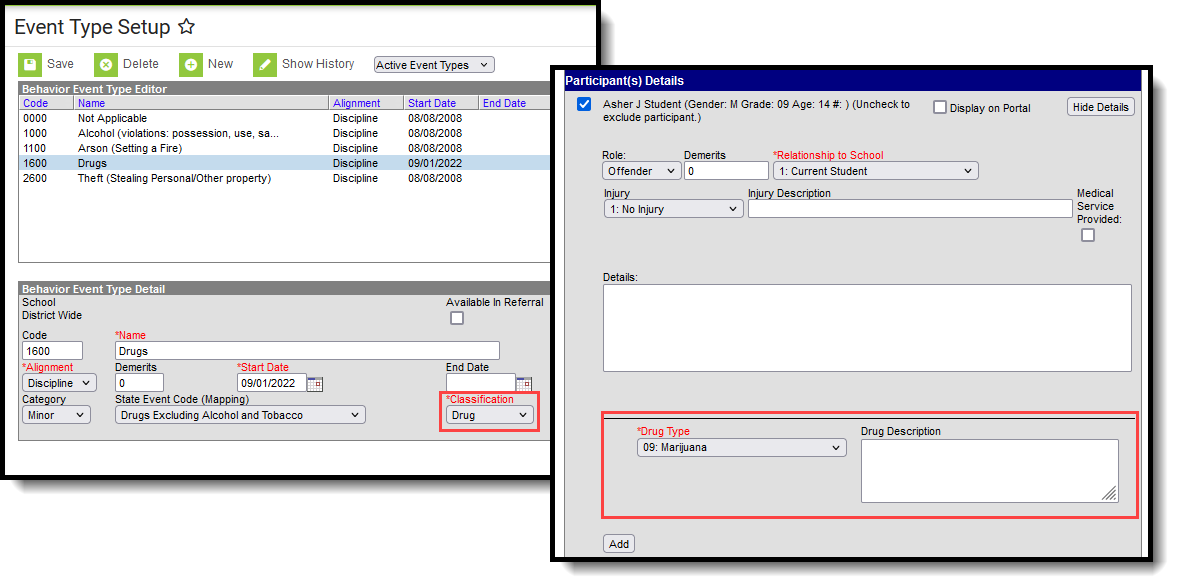 Behavior Event Classification
Behavior Event Classification
This selection displays the appropriate classification fields on the Behavior Participant editor when an individual is added to an event that is assigned a classification.
Resolution Types
Behavior Resolution Types organize the resolution of an event into categories.
 Behavior Resolution Types
Behavior Resolution Types
State Resolution Code (Mapping)
State Resolution Codes (also referred to as Discipline Action Types) indicate the type of disciplinary action taken for a student. These are the official state codes to which all district-defined behavior resolutions should be mapped. Behavior resolutions that are not mapped to a state event code do NOT report.
Click here to expand...
| Code | Description | Notes |
|---|
| 1 | Expulsion | An action taken by a local educational agency to remove a student from their regular school for disciplinary purposes for a period lasting longer than the permitted out-of-school suspension period allowed by the local educational agency policy. |
| 2 | In-School Suspension | Instance in which a student is temporarily removed from their regular classroom(s) for disciplinary purposes but remains under the direct supervision of school personnel. |
| 3 | Out-of-School Suspension | Instance in which a student is temporarily removed from their regular school for disciplinary purposes to another setting (e.g., home, behavior center). |
| 4 | Truancy | Event defined as (8) truancy days in one month. A truancy day may only be included in a single truancy event. A truancy day is an unexcused absence of one-half day or more. The definition of “an unexcused absence” is established at the district level. |
| 5 | Removal to an Alternative Educational Setting | Instance in which school personnel (not the IEP team) order the removal of a student with a disability from the student's current educational placement to an appropriate interim alternative educational setting for not more than 45 school days. |
Database Location:
BehaviorResType.stateResCode
Ad hoc Inquiries:
Student > Behavior > Behavior Resolution > behaviorDetail.stateResCode
Student > Behavior > Behavior Resolution > behaviorDetail.stateResName
Reports:
No reports
Response Types
Response Types are assigned to behavior incidents that require a restraint to be administered by the approved personnel. The fields on this editor are NOT localized; however, Response Types are needed in order to complete the Behavior Response on the Behavior Incident editor.
 Behavior Response Types
Behavior Response Types
Response Code and Name
Lists the code and name of the response.
Click here to expand...
Database Location:
BehaviorResponseType.name
BehaviorResponseType.code
Ad hoc Inquiries:
Student > Behavior > Behavior Resolution > responseCode (behaviorDetail.responseCode)
Reports:
Not reported
Type
Describes the way the restraint or seclusion was performed.
The use of chemical restraint, mechanical restraint or prone restraint on a student in a public education program in the State of Oregon is strictly prohibited.
The use of physical restraint or seclusion on a student in a public education program in the State of Oregon is prohibited unless used in the following manner:
- The student's behavior imposes a reasonable threat of imminent, serious bodily injury to the student or others; and
- Less restrictive interventions would not be effective.
See additional guidance on using restraints on the Oregon Department of Education website.
Click here to expand...
| Name | Description |
|---|
| M: Mechanical Restraint | A device is used to restrict movement of the student or the movement or normal function of a portion of the body of the student. |
| P: Physical Restraint | Restriction of a student's movement by one or more persons holding the student or applying physical pressure upon the student.
Physical Restraint DOES NOT include:- The touching or holding of a student without the use of force for the purpose of directing the student or assisting the student in completing a task or activity.
- Prone restraint (in which the student is held face down on the floor).
|
| S: Seclusion | Involuntary confinement of a student alone in a room from which the student is physically prevented from leaving.
Seclusion DOES NOT include the removal of a student for a short period of time to provide the student with an opportunity to regain self-control when the student is in a setting from which the student is not physically prevented from leaving. |
| O: Other | An other type of restraint or seclusion used in order to prevent bodily harm to students and staff. |
Database Location:
BehaviorResponseType.responseType
Ad hoc Inquiries:
Student > Behavior > Behavior Resolution > responseType (behaviorDetail.responseType)
Reports:
Not reported
Behavior Management
The Behavior Management tool is used to record all behavior incidents that occur in a school. Information is separated into Behavior Events, Participants in that event, and Resolutions to that event.
See the core Behavior Management article for information on recording and processing behavior incidents.
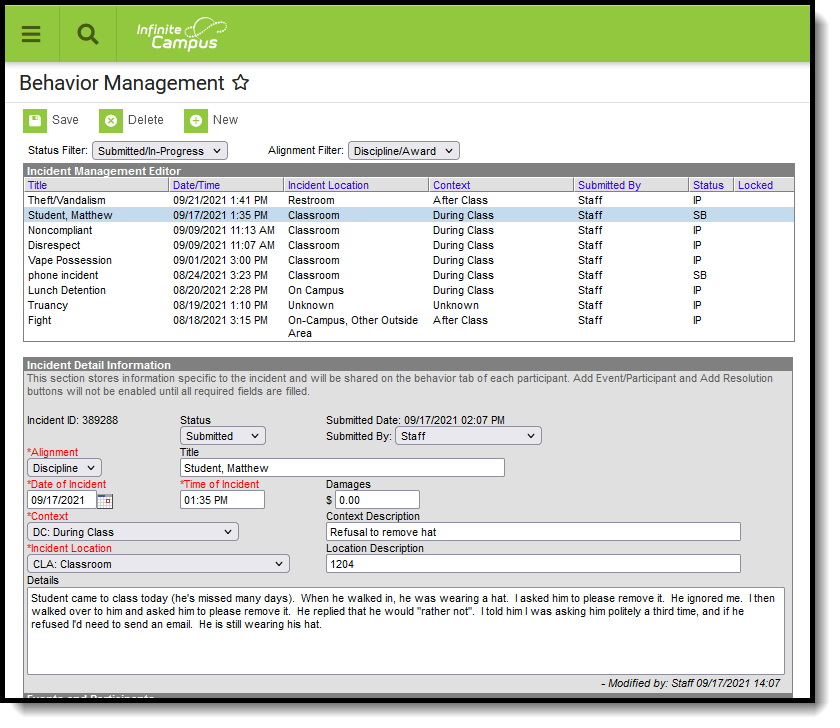 Behavior Management
Behavior Management
Participant Fields
Participants in a Behavior Incident can be offenders or witnesses.
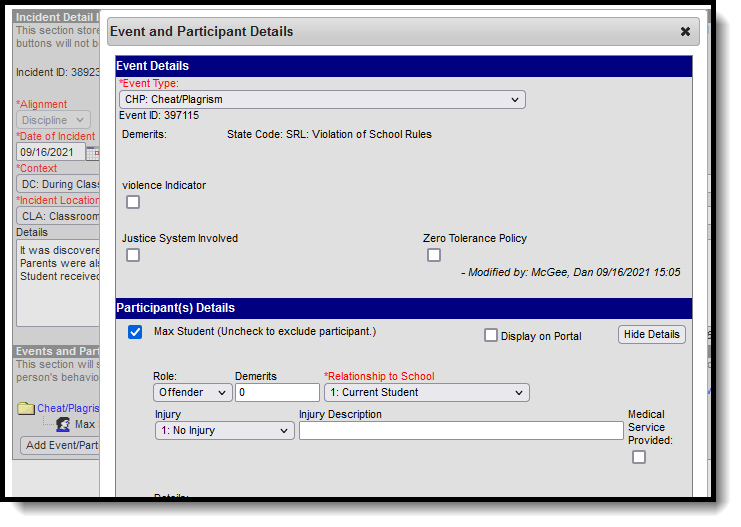 Behavior Event and Participation Fields
Behavior Event and Participation Fields
Weapon and Weapon Code
Indicates whether the incident triggering the disciplinary action involved a weapon. The event association with the resolution must have a Classification of Weapon in order to display and assign a Weapon to a participant on the Event Type Setup.
Click here to expand...
When a weapon is involved, the Weapon Code reports the type of weapon.
- When the Weapons Code assigned to the first offender of record is not null or NO, reports the first code entered.
- When the first offender of the record does not have a weapons code that is not null or NO, all other offenders on the reporting event (from first entered to last), if the weapons code is not null or NO, the first code entered reports.
- When all offenders do not have a weapons code entered other than null or NO, reports as NO.
| Code | Description | Notes |
|---|
| 0011 | Handgun | The weapon involved was a handgun or pistol. |
| 0012 | Shotgun/Rifle | The weapon involved was a shotgun or rifle. |
| 0013 | Other Type of Firearm (e.g., Bombs, Grenades, Starter Pistols) | The weapon involved was another type of firearm not named above, including zip guns, starter guns, and flare guns. |
| 0021 | Knife with Bade Length Less Than 2.5 inches | The weapon involved was a knife with a blade less than 2.5 inches in length. |
| 023 | Knife with Blade Length Greater Than or Equal to 2.5 inches | The weapon involved was a knife with a blade 2.5 inches or greater in length. |
| 0030 | Other Sharp Objects | The weapon involved was another type of sharp object, (e.g., razor blade, ice pick, dirk, Chinese star, other pointed instrument [used as a weapon]). |
| 0040 | Other Object | The weapon involved was another known object (e.g., chain, nunchakus, brass knuckle, billy club, electrical weapon or device [stun gun], BB or pellet gun). |
| 0050 | Substance Used as Weapon | The weapon involved was a substance (e.g., mace, tear gas) that was used as a weapon. |
| 0097 | Other | The incident involved a weapon other than those described above. |
| 0098 | No Weapon | No weapon was used in the incident. |
| 0099 | Unknown Weapon | A weapon was used in the incident, but the type is unknown. |
Database Location:
BehaviorWeapon.weaponCode
BehaviorWeapon.weaponDescription
Ad Hoc Inquiries:
Student > Behavior > Behavior Resolution > weaponCode (behaviorDetail.weaponCode)
Student > Behavior > Behavior Resolution > weaponCode (behaviorDetail.weaponDescription)
Reports:
Not reported
Resolution Fields
Behavior Management Resolution fields provide information on the consequence of the behavior incident.
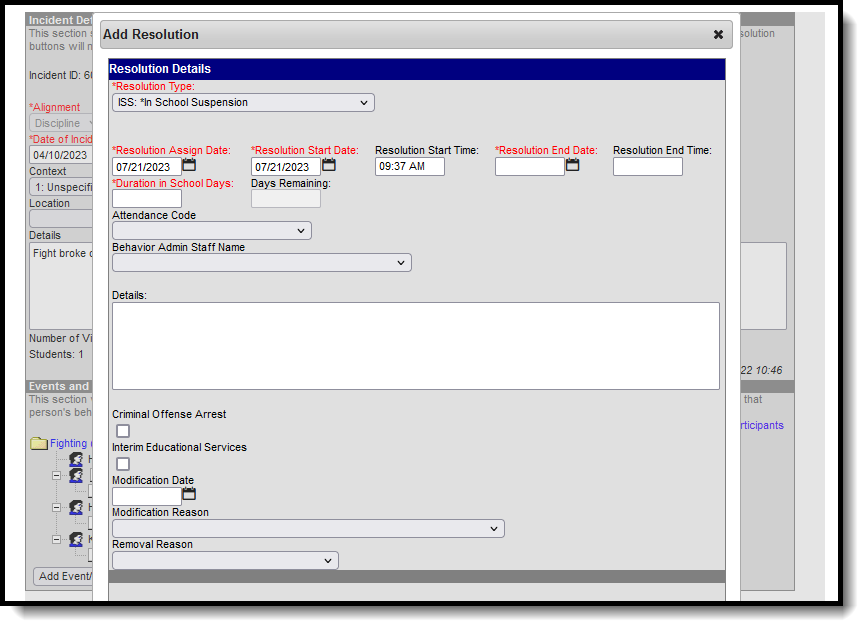 Behavior Resolution Editor
Behavior Resolution Editor
Criminal Offense Arrest
Indicates the incident resulted in the student's arrest for a violent criminal offense. Incidents included in this definition are as follows:
- Assault
- Manufacture of delivery of a controlled substance
- Sexual crimes using force, threatened use of force or against an incapacitated person
- Arson
- Robbery
- Hate/Bias Crime
- Coercion
- Kidnapping
Click here to expand...
Database Location:
BehaviorResolution.arrest
Ad Hoc Inquiries:
Student > Behavior > Behavior Resolution > resolutionArrest (behaviorDetail.resolutionArrest)
Reports:
Restraint and Seclusion File
Interim Educational Services
Indicates the district provided interim educational services to the student during the discipline days to enable the student to continue to participate in the general education curriculum and/or to progress toward meeting the goals set out in the student's IEP.
Click here to expand...
| When the Resolution is... | Mark the Interim Educational Services |
|---|
| 1: Expulsion | Yes or No (depends on the student) |
| 2: In-School Suspension | Yes |
| 3: Out of School Suspension | Yes or No (depends on the student) |
| 5: Removed to an Alternate Educational Setting | Yes |
Database Location:
BehaviorResolution.transferOption
Ad Hoc Inquiries:
Student > Behavior > Behavior Resolution > transferOption (behaviorDetail.transferOption)
Reports:
Restraint and Seclusion File
Modification Date
Reports the date the resolution was modified.
Click here to expand...
Database Location:
BehaviorResolution.modifcationDate
Ad Hoc Inquiries:
Student > Behavior > Behavior Resolution > modificationDate (behaviorDetail.modificationDate)
Reports:
Restraint and Seclusion File
Modification Reason
Describes special circumstances that may have modified the disciplinary action/resolution.
Click here to expand...
| Code | Name | Description |
|---|
| 0 | Not Applicable | Not Applicable |
| 1 | Shortened Weapons Expulsion | Duration of the weapons expulsion was modified (in writing) to be less than one year by the chief administering officer of the local educational agency (superintendent of the district). |
Database Location:
BehaviorResolution.modificationReason
Ad Hoc Inquiries:
Student > Behavior > Behavior Resolution > modificationReason (behaviorDetail.modificationReason)
Reports:
Restraint and Seclusion File
Removal Reason
Indicates the reason the student was removed.
Click here to expand...
| Code | Name | Description |
|---|
| 0 | Not Applicable | Not Applicable |
| 2 | Removal by Administrative Law Judge | Removal was ordered by an administrative law judge because the student exhibits behavior that is substantially likely to result in injury to the student or others. |
Database Location:
BehaviorResolution.removalReason
Ad Hoc Inquiries:
Student > Behavior > Behavior Resolution > removalReason (behaviorDetail.removalReason)
Reports:
Restraint and Seclusion File
Behavior Response Fields
Behavior Response fields provide details on the activity surrounding the restraint and seclusion of a student when the behavior incident required that response.
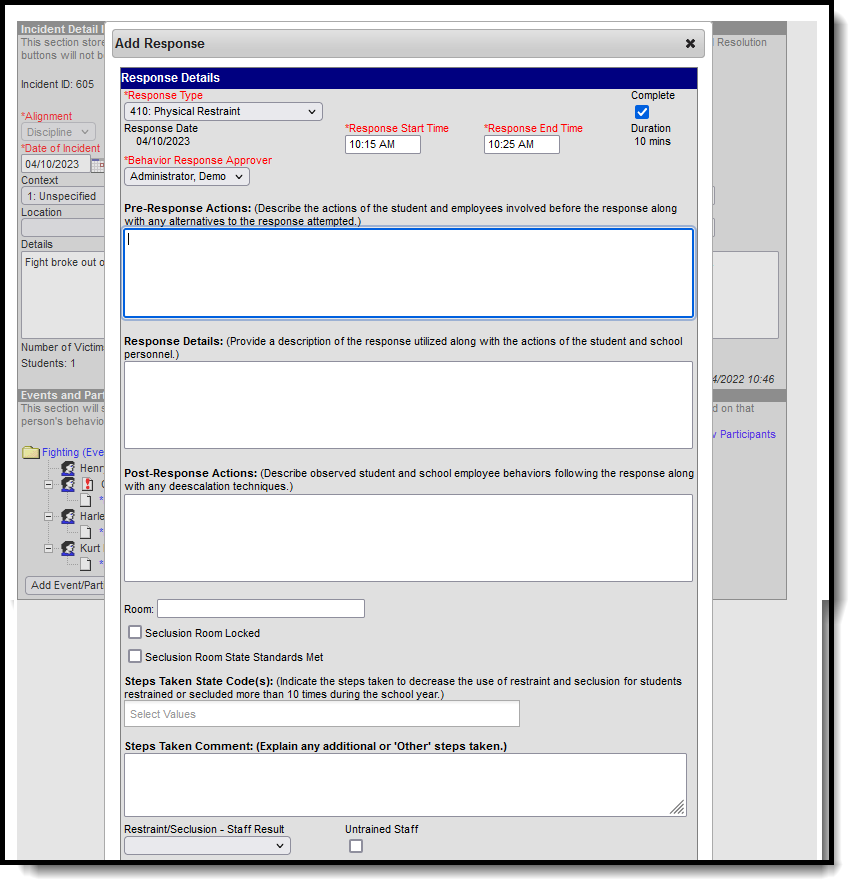 Behavior Response Details
Behavior Response Details
Seclusion Room Locked
Indicates the seclusion occurred in a locked room.
Click here to expand...
Database Location:
BehaviorResponse.seclusionRoomLocked
Ad Hoc Inquiries:
Student > Behavior > Behavior Response > seclusionRoomLocked (behaviorDetail.seclusionRoomLocked)
Reports:
Restraint and Seclusion File
Seclusion Room State Standards Met
When marked, indicates the seclusion room meets all standards for seclusiom.
Click here to expand...
Database Location:
BehaviorResponse.seclusionRoomStandards
Ad Hoc Inquiries:
Student > Behavior > Behavior Response > seclusionRoomStateStandards (behaviorDetail.seclusionRoomStateStandards)
Reports:
Restraint and Seclusion File
Steps Taken State Code
Selection indicates the steps taken to decrease the use of the restraint and seclusion for students restrained or secluded more than 10 times during the school year.
Click here to expand...
Code
| Name
| Description
|
|---|
000
| None
|
|
010
| Additional Adult Support
| Additional adult support and/or one on one staffing
|
020
| Basic Needs
| Assure basic needs are met (food/sleep/meds)
|
030
| Check-in/Check-out
| Provided check-in/check-out support programming
|
040
| Counseling
| Provided student with counseling services
|
050
| FBA
| Initiated/reviewed or revised the student's Functional Behavior Assessment
|
060
| BIP
| Developed/reviewed or revised the student's Behavior Intervention Plan
|
070
| Safety Plan
| Develop/reviewed or revised the student's individualized safety plan
|
080
| Adjusted Transitions
| Adjusted transitions (gave longer transition time, delayed passing)
|
090
| Meeting Held
| Meeting help with parents and/or others to provide support to student
|
100
| Options/Choices
| Offered student options and/or choices
|
110
| Preferred Activity
| Offered student a preferred activity
|
120
| Quiet Space
| Offered student a quiet space/location
|
130
| Sensory Tools/Calming
| Offered student sensory tools and/or calming techniques
|
140
| Snack
| Offered student a snack
|
150
| Walk
| Offered student a walk/went for a walk with the student
|
160
| Ongoing staff training
| Ongoing training to all staff working with the student
|
170
| Positive reinforcement system
| Utilized the student's individualized positive reinforcement system
|
180
| Breaks
| Provided/offered student to take a break
|
190
| Provide visuals
| Provided/offered support via visual prompts/cues
|
200
| Reduce demands
| Reduced the task and/or communication demands placed upon the student
|
210
| Remove triggers
| Removed known triggers from the environment
|
220
| Social stories
| Provided/offered situationally relevant social stories
|
230
| Specialist support
| Specialist support (Child Development Specialist, Autism Specialist, School Psychologist)
|
240
| Staff Switch
| Switch staffing to a different staff member
|
250
| Verbal redirection
| Provided/offered verbal redirection to the student
|
260
| Planned Ignoring
| Planned Ignoring
|
270
| Increased home/school communication
| Increased home/school communication
|
999
| Other
| Other steps taken detailed in comment field
|
Database Location:
BehaviorResponse.stepsTakenRestraint
Ad Hoc Inquiries:
Student > Behavior > Behavior Response > stepsTakenRestraint (behaviorDetail.stepsTakenRestraint)
Reports:
Restraint and Seclusion File
Steps Taken Comment
Provides information on the steps that were taken to restrain and/or seclude the student during the behavior incident. Allows up to 500 characters.
Click here to expand...
Database Location:
BehaviorResponse.stepsTakenComment
Ad Hoc Inquiries:
Student > Behavior > Behavior Response > stepsTakenComment (behaviorDetail.stepsTakenComment)
Reports:
Restraint and Seclusion File
Student was Injured During Response
When marked, indicates the use of the restraint or seclusion resulted in the injury of a student.
Click here to expand...
Database Location:
BehaviorResponse.studentInjuredResponse
Ad Hoc Inquiries:
Student > Behavior > Behavior Response > responseStudentInjury (behaviorDetail.responseStudentInjury)
Reports:
Restraint and Seclusion File
Student Died during Response
When marked, indicates the use of the restraint or seclusion resulted in the death of a student.
Click here to expand...
Database Location:
BehaviorResponse.studentDiedResponse
Ad Hoc Inquiries:
Student > Behavior > Behavior Response > studentDiedResponse (behaviorDetail.studentDiedResponse)
Reports:
Restraint and Seclusion File
Restraint/Seclusion - Staff Result
Indicates the use of restraint or seclusion resulted in the death or injury of a staff member.
Click here to expand...
| Code | Name |
|---|
| ISM | Injury of Staff Member |
| DSM | Death of Staff Member |
Database Location:
BehaviorResponse.restraintSeclusion
Ad Hoc Inquiries:
Student > Behavior > Behavior Response > restraintSeclusion (behaviorDetail.restraintSeclusion)
Reports:
Restraint and Seclusion File
Untrained Staff
Indicates that at least one staff member administering the restraint or seclusion during this incident was not trained.
Click here to expand...
Database Location:
BehaviorResponse.untrainedStaff
Ad Hoc Inquiries:
Student > Behavior > Behavior Response > untrainedStaff (behaviorDetail.untrainedStaff)
Reports:
Restraint and Seclusion File
 Event Type Setup
Event Type Setup Behavior Resolution Types
Behavior Resolution Types Behavior Response Types
Behavior Response Types Behavior Management
Behavior Management
 Behavior Event and Participation Fields
Behavior Event and Participation Fields
 Behavior Resolution Editor
Behavior Resolution Editor

